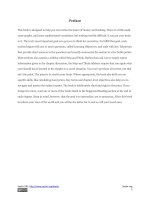Money and Banking: Lecture 39
Bạn đang xem bản rút gọn của tài liệu. Xem và tải ngay bản đầy đủ của tài liệu tại đây (474.25 KB, 14 trang )
Money and
Banking
Lecture 39
Review of the Previous Lecture
• Monetary Aggregates
• Equation of Exchange
• MV = PY
• Quantity Theory of Money
• Facts about Velocity of Money
• Demand for Money
• Transactions Demand for money
The Portfolio Demand for
Money
•
•
Money is just one of many financial
instruments that we can hold in our
investment portfolios.
Expectations that interest rates will
change in the future are related to the
expected return on a bond and also
affect the demand for money.
•
•
•
When interest rates are expected to rise,
money demand goes up as people
switch from holding bonds into holding
money.
The demand for money will also be
affected by changes in the riskiness of
other assets; as their risk increases so
does the demand for money.
Money demand will increase if other
assets become less liquid.
Targeting Money Growth in a
Low-Inflation Environment
• In the long run, inflation is tied to money
growth.
• In a high-inflation environment moderate
variations in the growth of velocity are a
mere annoyance.
• the only solution to inflation in a high
inflation environment is to reduce money
growth.
Targeting Money Growth in a
Low-Inflation Environment
In a low-inflation environment, the ability to
use money growth as a policy guide
depends on the stability of the velocity of
money.
Targeting Money Growth in a
Low-Inflation Environment
Two criteria for the use of money growth as
a direct monetary policy target:
• A stable link between the monetary base and
the quantity of money
• A predictable relationship between the
quantity of money and inflation
Targeting Money Growth in a
Low-Inflation Environment
These allow policymakers to
• predict the impact of changes in the central
bank’s balance sheet on the quantity of
money
• translate changes in money growth into
changes in inflation.
Output and Inflation in the Long Run
• Potential Output
• Potential output is what the economy is capable of
producing when its resources are used at normal
rates.
• Potential output is not a fixed level, because the
amount of labor and capital in an economy can
grow, and improved technology can increase the
efficiency of the production process
• Unexpected events can push current output away
from potential output, creating an output gap
• In the long run, current output equals potential
output.
Output and Inflation in the Long Run
•
Long-Run Inflation
•
•
•
In the long run, since current output equals
potential output, real growth must equal growth
in potential output.
Ignoring changes in velocity, in the long run,
inflation equals money growth minus growth in
potential output.
Though central banks focus on controlling short
term nominal interest rates, they keep an eye
on money growth
•
When they try to adjust level of reserves in banking
system to maintain interest rate, it affects money
growth. Which in turn determines inflation
Money Growth, Inflation, and Aggregate
Demand
• Aggregate demand tells us how spending
(demand) by households, firms, the
government, and foreigners changes as
inflation goes up and down.
• The level of aggregate demand is tied to
monetary policy through the equation of
exchange (MV=PY) because the amount
of money in the economy limits the ability
to make payments .
Money Growth, Inflation, and Aggregate
Demand
• Rearranging the equation of exchange
Y
ad
MV
P
• where Yad = aggregate demand,
•
M = the quantity of money,
•
V = the velocity of money, and
•
P = the price level.
• From this expression it is clear that an increase
in the price level reduces the purchasing power
of money, which means less purchases are
made, pushing down aggregate demand
Money Growth, Inflation, and Aggregate
Demand
Money Growth
Inflation
Unchanged
and less than
inflation
M
P
Velocity
Unchanged
Aggregate ad
Demand Y









